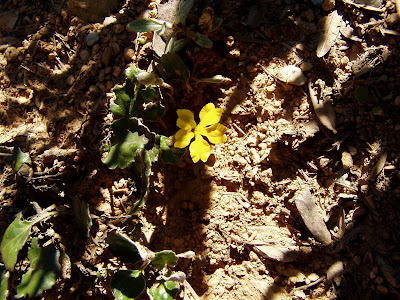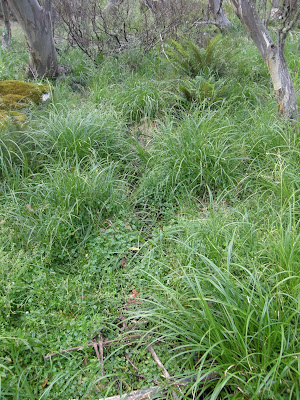The following photographs have been taken over a number of years; up to and including the year 2008. All photographs were taken over the summer months.


Top - Bush of Daisy type flowers. Middle - Six species appear in this photo. Bottom - Possibly an Alpine Pepper.
The photographs posted in this blog are for future reference for anybody studying the effects of change etc in this mountain area. The vast majority of photographs were taken above the level of the McIvor Track, others were taken no further than a kilometre and a half down the south east side of the mountain, from the turn off into Fire Tower Reserve. The photographs show, plants, flowers, and trees that grow on Mount Useful.
My disclaimer is, I know very little about the science or ecology of this area, so many of the photographs shown here may be written up wrongly - or not at all, for this I apologise; my main aim was to photograph what is here now, and leave the technical details to others in the future.
* I have posted only large photographs in this Blog, mainly to highlight the item photographed. Some photos could be of better quality and these will be replaced if better photographs become available. More flora will be added in time.
Ray.
Updates.
MATURE BUSHLAND
The following series of photographs depict the health and condition of the flora prior to the Great Alpine Fires of December 2006.

A water point 100 metres northwest of the roadway into Fire Tower Reserve

The three above photographs, and the two below show a healthy mature forest , and wet soaks prior to the fires of 2007. Below healthy grasses and ferns grow happily together
THE TREES and SMALLER SHRUBS

Here you can see bare rocky ground which has helped spare the area from more damage


The above two photographs show complete devastation of the Snow Gum forest; reasoning, the undergrowth around trees was very heavy, affording them no protection. My observations show that the vast number of these trees shoot new growth from their base, even though the trees look dead, (this can be seen in the third photograph above - left hand side).
The above two photographs show a very rare sight; two Snow Gums shooting new growth amongst the tens of thousands of dead trees growing in this reserve. Why this has happened I don't know for the same trees have the same thin bark as those trees which are dead.
The above two photographs show a very rare sight; two Snow Gums shooting new growth amongst the tens of thousands of dead trees growing in this reserve. Why this has happened I don't know for the same trees have the same thin bark as those trees which are dead.

The rocky area here has provided no protection at all because the fire here was driven uphill by strong wind

Protection is everything, these ferns grow 2 metres from the trees above

A flowering gum tree growing in a moist gully environment

Snow Gum seedlings come to life after a hot fire event

Rich ash laden soils produce prolific numbers of Snow Gum seedlings; as they grow in size the stronger seedlings will eventually choke out kill off the smaller growing rivals, allowing only a limited number of trees to become established in the area

Taken 300 metres below the mountain top, this photograph shows what appears to be two different types of leaf structure, growing from two similar type trees





The Woolly Tea Tree at 1400 metres

Possibly an Alpine Shaggy-Pea

A rough leaf Current Bush

Alpine Ballart

These fruits/seeds were found in 2003, at the head of a reasonably wet gully 100 metres on the south side of the turn off into Mount Useful.
THE FLOWERS
As there are many similar flowers throughout the Australian Alpine area, it is beyond my scope to know if the photographs posted here have been correctly identified.

The Grass Leaf Trigger Plant

Possibly Pink Bells or Mountain Boronia








Candles

Native Violets





Possibly a "Velleia species"

(Daisy) Button Everlasting
Daisy - Chamomile Sunray
Daisy - Hoary Sunray
]
]
Bitter-cresses


Sky Lily

Alpine Stackhousia






Prickly Starwort


THE GRASSES and SMALL PLANTS
This photograph shows what the original landscape looked like prior to the 2006/07 bushfire season.

Twelve months later metre high grasses can be seen growing in the background (above and below); many parts of the high country presently look like this (below) as the trees and undergrowth slowly grow back to maturity.


Seed head of the metre high grass
Young Tussock Grasses


































